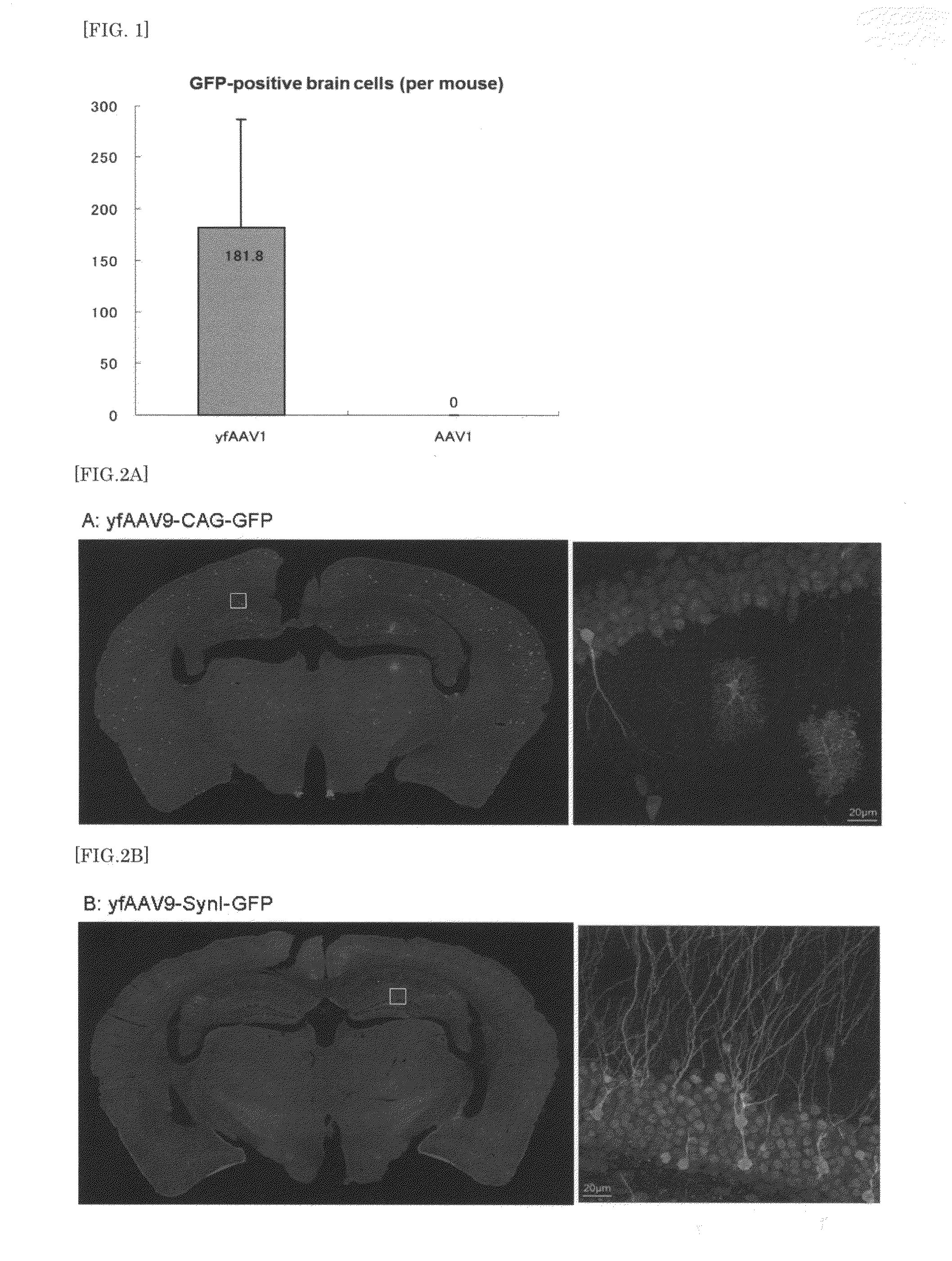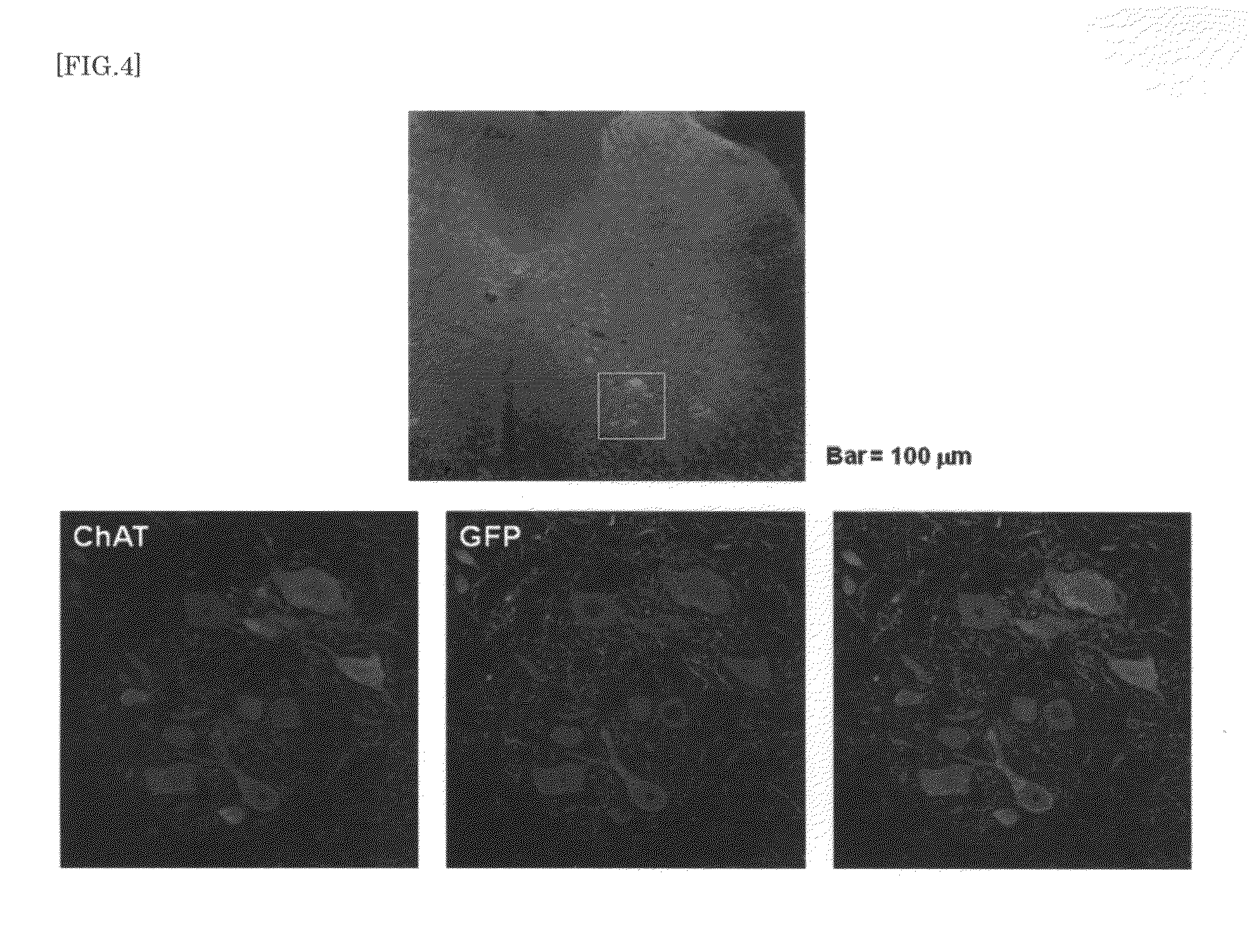Adeno-Associated Virus Virion for Gene Transfer to Nervous System Cells
a technology of adenovirus and gene transfer, which is applied in the direction of viruses/bacteriophages, drug compositions, peptides/proteins, etc., can solve the problems of drug inability to pass through the blood-brain barrier, drug efficiency is often inefficient, and the treatment application of recombinant viral vectors is limited. , to achieve the effect of high efficiency
- Summary
- Abstract
- Description
- Claims
- Application Information
AI Technical Summary
Benefits of technology
Problems solved by technology
Method used
Image
Examples
example 1
[0132]1. Gene Transfer to Nerve Cells in the Brain of Adult Mice
[0133](1) Intracardial Administration of rAAV Vector in Mice
[0134]Animals used were 30 male C57BL6 adult mice at 4 months old after birth (3 mice for each vector). After anesthesia by intraperitoneal administration of 200 μl per 30 g body weight of Nembutal, the mice were fixed on a stereotaxic apparatus for small animals. The mice were injected with each dilution of the above vectors diluted in PBS at 2×1012 vg (dose volume: 100 μl), using a 1 ml insulin syringe via percutaneous puncture of the left ventricle. The mice were observed in a cage placed on a heating pad until they awoke from anesthesia. Thereafter, the mouse cage was put back in a rack for infected animals.
[0135](2) Immunohistochemistry
[0136]Under deep anesthesia, mice were infused with PBS and then with ice-chilled 4% PFA. The brain and spinal cord were dissected and then postfixed for 4 hours in 4% PFA. A slice (40 μm) of brain coronal sections in the ra...
example 2
[0153]Gene Transfer to Fetal Brain Through Peripheral Administration to Mother Mice
[0154]It is reported that a gene was transferred to fetal mice by intraamniotically administering the rAAV vector to mother mice (RAHIM ET AL., FASEB Journal, pp 1-14, Vol. 25 Oct. 2011). Therefore, gene transfer to fetal mice by peripheral administration of the rAAV vector of the present invention to mother mice was examined
[0155]Materials and Methods[0156]rAAV Vector: yfAAV9-SynI-AcGFP1 (Sample ID: 9)[0157]Titer: 1.3×1013 vector genome / ml[0158]Dosing Volume: 50 μl
[0159]Method of Administration
[0160]On Day 13 of pregnancy, the rAAV vector above was given to mother mice (3) by intracardial administration. For their offspring mice (9 in total), the coronal section slices (40 μm thick) from the area around the hippocampus of each brain on Day 1 and Weeks 3, 4 and 11 after birth were prepared through infusion and fixation with 4% paraformaldehyde (PFA). GFP expressed in nerve cells in each of the sliced ...
example 3
[0163]Expression Regulation by Aromatic Amino Acid Decarboxylase (AADC) In Brain Nerve Cells Using the Recombinant AAV Vector: yfAAV9-SynI-GFP-miAADC
[0164]It was investigated to determine if the rAAV vector of the present invention is useful as a therapeutic vector that can regulate the expression of endogenous gene, by incorporating miRNA, etc. into viral genome. Specific procedures are as follows: an rAAV vector was constructed from yfAAV9-SynI-GFP (Sample ID: 9) as a basis to contain yfAAV9 as a capsid protein and express miRNA against mouse aromatic amino acid decarboxylase (AADC) and green fluorescent protein (GFP) by nerve cell-specific Synapsin I promoter. The vector was given to mice and examined if the vector could decrease AADC in the brain nerve cells.
[0165]For the miRNA used, the sequence described below was synthesized to obtain 5′-TGCCTTTATGTCCTGAATT-3′ (SEQ ID NO: 27) corresponding to the nucleotide positions 831 to 851 of mouse AADC (GenBank accession No. NM—016672)....
PUM
| Property | Measurement | Unit |
|---|---|---|
| Fraction | aaaaa | aaaaa |
| Digital information | aaaaa | aaaaa |
| Length | aaaaa | aaaaa |
Abstract
Description
Claims
Application Information
 Login to View More
Login to View More - R&D
- Intellectual Property
- Life Sciences
- Materials
- Tech Scout
- Unparalleled Data Quality
- Higher Quality Content
- 60% Fewer Hallucinations
Browse by: Latest US Patents, China's latest patents, Technical Efficacy Thesaurus, Application Domain, Technology Topic, Popular Technical Reports.
© 2025 PatSnap. All rights reserved.Legal|Privacy policy|Modern Slavery Act Transparency Statement|Sitemap|About US| Contact US: help@patsnap.com



